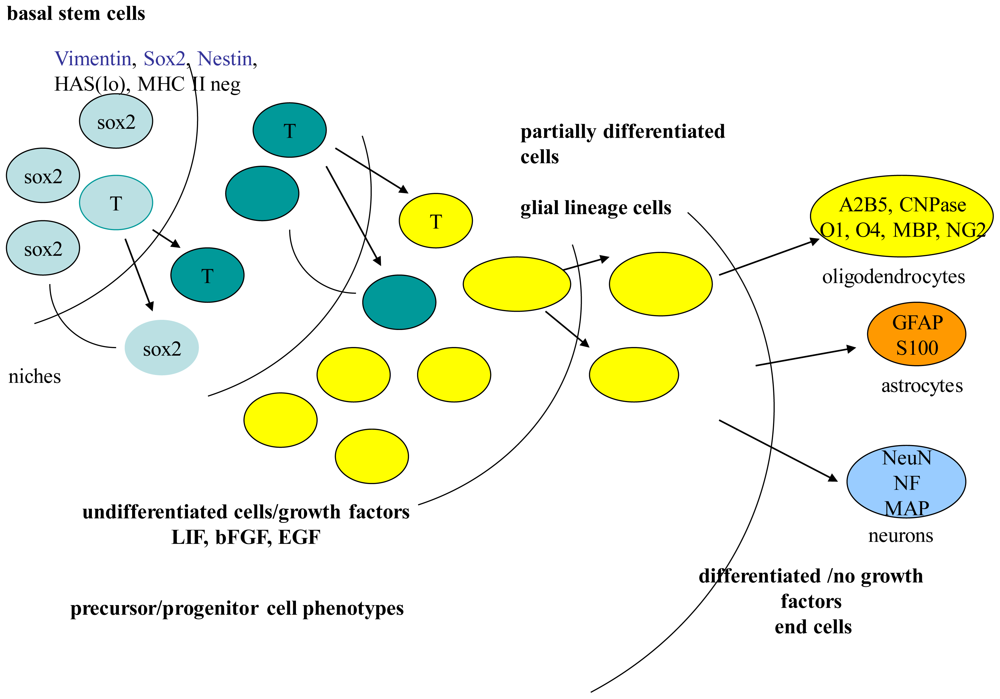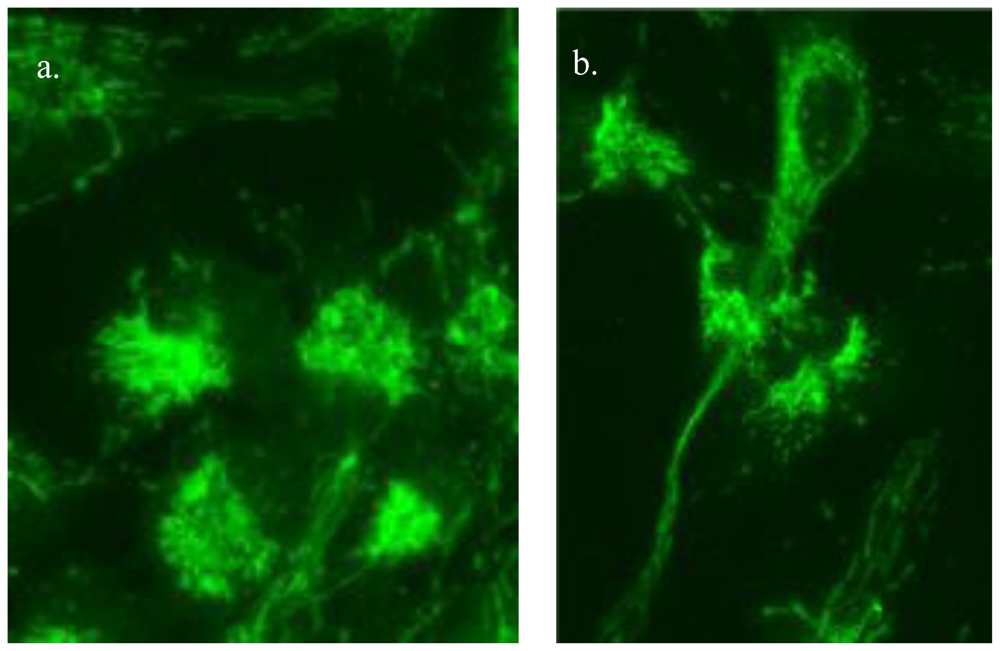Stem Cells and Neuroprotection: Understanding the Players
Abstract
:1. Introduction
2. Multiple Mechanisms May Mediate Stem Cell Responses
2.1. Stem Cell Types and Renewal
2.2. Stem Cells Age
2.3. Telomerase “Immortality”
2.4. “Gender Matters”
2.5. Mitochondrial Dynamics
3. Conclusions
References
- Park, A. The Quest Resumes. Time 2009, 173, 38–45. [Google Scholar]
- Longaker, MT; Baker, LC; Greely, HT. Proposition 71 and CIRM—assessing the return on investment. Nat. Biotechnol 2007, 25, 513–521. [Google Scholar]
- Gearhart, J. A decade of stem-cell research. An interview with John Gearhart, Director of the Institute for Regenerative Medicine at the University of Pennsylvania, USA. Interview by Howard Wolinsky. EMBO Rep 2009, 10, 12–16. [Google Scholar]
- Hipp, J; Atala, A. Sources of stem cells for regenerative medicine. Stem Cell Rev 2008, 4, 3–11. [Google Scholar]
- Zech, HH; Shkumatov, A; Koestenbauer, S. The magic behind stem cells. J. Assist. Reprod. Genet 2007, 24, 208–214. [Google Scholar]
- Siggins, RW; Zhang, P; Welsh, D; Lecapitaine, NJ; Nelson, S. Stem cells, phenotypic inversion, and differentiation. Int. J. Clin. Exp. Med 2008, 1, 2–21. [Google Scholar]
- Emsley, JG; Mitchell, BD; Kempermann, G; Macklis, JD. Adult neurogenesis and repair of the adult CNS with neural progenitors, precursors, and stem cells. Prog. Neurobiol 2005, 75, 321–341. [Google Scholar]
- Ninkovic, J; Gotz, M. Signaling in adult neurogenesis: From stem cell niche to neuronal networks. Curr. Opin. Neurobiol 2007, 17, 338–344. [Google Scholar]
- Zhang, B; Pan, X; Anderson, TA. MicroRNA: A new player in stem cells. J. Cell Physiol 2006, 209, 266–269. [Google Scholar]
- Ren, J; Jin, P; Wang, E; Marincola, FM; Stroncek, DF. MicroRNA and gene expression patterns in the differentiation of human embryonic stem cells. J. Tranl. Med 2009. [Google Scholar] [CrossRef]
- Gunaratne, PH. Embryonic stem cell microRNAs: Defining factors in induced pluripotent (iPS) and cancer (CSC) stem cells? Curr. Stem Cell Res. Ther 2009, 4, 168–177. [Google Scholar]
- Ciaudo, C; Servant, N; Cognat, V; Sarazin, A; Kieffer, E; Viville, S; Colot, V; Barillot, E; Heard, E; Voinnet, O. Highly dynamic and sex-specific expression of microRNAs during early ES cell differentiation. PLoS Genet 2009, 5, e1000620. [Google Scholar]
- Tureyen, K; Vemuganti, R; Bowen, KK; Sailor, KA; Dempsey, RJ. EGF and FGF-2 infusion increases post-ischemic neural progenitor cell proliferation in the adult rat brain. Neurosurgery 2005, 57, 1254–1263. [Google Scholar]
- Shetty, AK; Hattiangady, B; Shetty, GA. Stem/progenitor cell proliferation factors FGF-2, IGF-1, and VEGF exhibit early decline during the course of aging in the hippocampus: role of astrocytes. Glia 2005, 51, 173–186. [Google Scholar]
- Bull, ND; Bartlett, PF. The adult mouse hippocampal progenitor is neurogenic but not a stem cell. J. Neurosci 2005, 25, 10815–10821. [Google Scholar]
- Korochkin, LI; Revishchin, AV; Okhotin, VE. Neural stem cells and their role in recovery processes in the nervous system. Neurosci. Behav. Physiol 2006, 36, 499–512. [Google Scholar]
- Brewer, GJ. Regeneration and proliferation of embryonic and adult rat hippocampal neurons in culture. Exp. Neurol 1999, 159, 237–247. [Google Scholar]
- Carpenter, G; Cohen, S. Epidermal growth factor. J. Biol. Chem 1990, 265, 7709–7712. [Google Scholar]
- Kukekov, VG; Laywell, ED; Suslov, O; Davies, K; Scheffler, B; Thomas, LB; O’Brien, TF; Kusakabe, M; Steindler, DA. Multipotent stem/progenitor cells with similar properties arise from two neurogenic regions of adult human brain. Exp. Neurol 1999, 156, 333–344. [Google Scholar]
- Roy, NS; Wang, S; Jiang, L; Kang, J; Benraiss, A; Harrison-Restelli, C; Fraser, RA; Couldwell, WT; Kawaguchi, A; Okano, H; Nedergaard, M; Goldman, SA. In vitro neurogenesis by progenitor cells isolated from the adult human hippocampus. Nat. Med 2000, 6, 271–277. [Google Scholar]
- Gage, FH; Kempermann, G; Palmer, TD; Peterson, DA; Ray, J. Multipotent progenitor cells in the adult dentate gyrus. J. Neurobiol 1998, 36, 249–266. [Google Scholar]
- Terman, A; Kurz, T; Navratil, M; Arriaga, EA; Brunk, UT. Mitochondrial turnover and aging of long-lived postmitotic cells. Antioxidants Redox Signal 2010, 12, 503–535. [Google Scholar]
- Hattiangady, B; Shetty, AK. Implications of decreased hippocampal neurogenesis in chronic temporal lobe epilepsy. Epilepsia 2008, 49, 26–41. [Google Scholar]
- He, P; Iwashita, T; Buchstaller, J; Molofsky, AV; Thomas, D; Morrison, SJ. Bmi-1 over-expression in neural stem/progenitor cells increases proliferation and neurogenesis in culture but has little effect on these functions in vivo. Dev. Biol 2009, 328, 257–272. [Google Scholar]
- Sahin, E; DePinho, RA. Linking functional decline of telomeres, mitochondria and stem cells during ageing. Nature 2010, 464, 520–528. [Google Scholar]
- Levi, BP; Morrison, SJ. Stem cells use distinct self-renewal programs at different ages. Cold Spring Harbor Symp. Quant. Biol 2008, 73, 539–553. [Google Scholar]
- Li, XL; Wang, deS; Qu, HY; Zhao, BQ; Zhang, T; Zhou, T; Li, Q; Sun, MJ. Changes of autologous neural stem cells in the hippocampi of aging mice. Neurosci. Lett 2009, 463, 119–124. [Google Scholar]
- Bailey, KJ; Maslov, AY; Pruitt, SC. Accumulation of mutations and somatic selection in aging neural stem/progenitor cells. Aging Cell 2004, 3, 391–397. [Google Scholar]
- Ju, Z; Rudolph, L. Telomere dysfunction and stem cell ageing. BioChimie 2008, 90, 24–32. [Google Scholar]
- Caporaso, GL; Lim, DA; Alvarez-Buylla, A; Chao, MV. Telomerase activity in the subventricular zone of adult mice. Mol. Cell Neurosci 2003, 23, 693–702. [Google Scholar]
- Flores, I; Benetti, R; Blasco, MA. Telomerase regulation and stem cell behaviour. Curr. Opin. Cell Biol 2006, 18, 254–260. [Google Scholar]
- Flores, I; Canela, A; Vera, E; Tejera, A; Cotsarelis, G; Blasco, MA. The longest telomeres: A general signature of adult stem cell compartments. The longest telomeres: A general signature of adult stem cell compartments. Genes Dev 2008, 22, 654–667. [Google Scholar]
- Kang, HJ; Choi, YS; Hong, S-B; Kim, K-W; Woo, R-S; Won, SJ; Kim, EJ; Jeon, HK; Jo, S-Y; Kim, TK; Bachoo, R; Reynolds, IJ; Gwag, BJ; Lee, H-W. Ectopic expression of the catalytic subunit of telomerase protects against brain injury resulting from ischemia and NMDA-induced neurotoxicity. Neurobiol. Dis 2004, 24, 1280–1287. [Google Scholar]
- Richardson, RM; Nguyen, B; Holt, SE; Broaddus, WC; Fillmore, HL. Ectopic telomerase expression inhibits neuronal differentiation of NT2 neural progenitor cells. Neurosci. Lett 2007, 421, 168–172. [Google Scholar]
- Anasetti, C. What are the most important donor and recipient factors affecting the outcome of related and unrelated allogeneic transplantation? Best Pract. Res. Clin. Haematol 2008, 21, 691–697. [Google Scholar]
- Deasy, BM; Lu, A; Tebbets, JC; Feduska, JM; Schugar, RC; Pollett, JB; Sun, B; Urish, KL; Gharaibeh, BM; Cao, B; Rubin, RT; Huard, JA. Role for cell sex in stem cell-mediated skeletal muscle regeneration: Female cells have higher muscle regeneration efficiency. J. Cell Biol 2007, 177, 73–86. [Google Scholar]
- Liu, M; Dziennis, S; Hurn, PD; Alkeyed, NJ. Mechanisms of gender-linked ischemic brain injury. Restor. Neurol. Neurosci 2009, 27, 163–179. [Google Scholar]
- Berry, C; Ley, EJ; Tillou, A; Cryer, G; Margulies, DR; Salim, A. The effect of gender on patients with moderate to severe head injuries. J. Truama 2009, 67, 950–953. [Google Scholar]
- Herson, PS; Koerner, IP; Hurn, PD. Sex, sex steroids, and brain injury. Semin Reprod. Med 2009, 27, 229–239. [Google Scholar]
- Ottochian, M; Salim, A; Berry, C; Chan, LS; Wilson, MT; Margulies, DR. Severe traumatic brain injury: Is there a gender difference in mortality? Am. J. Surg 2009, 197, 155–158. [Google Scholar]
- Csete, M. Gender issues in transplantation. Anesth. Analg 2008, 107, 232–238. [Google Scholar]
- Yuan, J; Yu, JX; Ge, J. Sexual dimorphism on the neurogenic potential of rhesus monkeys mesenchymal stem cells. Biochem. Biophys. Res. Commun 2010, 396, 394–400. [Google Scholar]
- Galea, LA; Spritzer, MD; Barker, JM; Pawluski, JL. Gonadal hormone modulation of hippocampal neurogenesis in the adult. Hippocampus 2006, 16, 225–232. [Google Scholar]
- Bianchi, DW; Fisk, NM. Fetomaternal cell trafficking and the stem cell debate: Gender matters. JAMA 2007, 297, 1489–1491. [Google Scholar]
- Klonisch, T; Drouin, R. Fetal-maternal exchange of multipotent stem/progenitor cells: Microchimerism in diagnosis and disease. Trends Mol. Med 2009, 15, 510–518. [Google Scholar]
- Troeger, C; Perahud, I; Moser, S; Hozgreve, W. Transplacental traffic after in-utero mesenchymal stem cell transplantation. Stem Cells Dev 2010. [Google Scholar] [CrossRef]
- Nesti, C; Paquali, L; Vaglini, F; Siciliano, G; Murri, L. The role of mitochondria in stem cell biology. Biosci. Rep 2007, 27, 165–171. [Google Scholar]
- Facucho-Oliveira, JM; StJohn, JC. The relationship between pluripotency and mitochondrial DNA proliferation during early embryo development and embryonic stem cell differentiation. Stem Cell. Rev. Rep 2009, 5, 140–158. [Google Scholar]
- Parker, GC; Acsadi, G; Brenner, CA. Mitochondria: Determinants of stem cell fate? Stem Cells Develop 2009, 18, 803–806. [Google Scholar]
- Jezek, P; Plecita-Hlavata, L; Smolkova, K; Rossignol, R. Distinctions and similarities of cell bioenergetics and the role of mitochondria in hypoxia, cancer, and embryonic development. Int. J. Biochem. Cell Biol 2010, 42, 604–622. [Google Scholar]



© 2010 by the authors; licensee Molecular Diversity Preservation International, Basel, Switzerland. This article is an open-access article distributed under the terms and conditions of the Creative Commons Attribution license (http://creativecommons.org/licenses/by/3.0/).
Share and Cite
Pearce, V. Stem Cells and Neuroprotection: Understanding the Players. Int. J. Mol. Sci. 2010, 11, 3288-3297. https://doi.org/10.3390/ijms11093288
Pearce V. Stem Cells and Neuroprotection: Understanding the Players. International Journal of Molecular Sciences. 2010; 11(9):3288-3297. https://doi.org/10.3390/ijms11093288
Chicago/Turabian StylePearce, Virginia. 2010. "Stem Cells and Neuroprotection: Understanding the Players" International Journal of Molecular Sciences 11, no. 9: 3288-3297. https://doi.org/10.3390/ijms11093288



